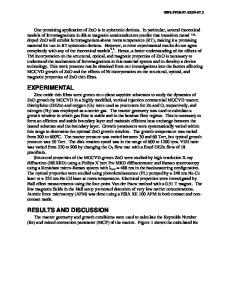Vapor deposition of aluminium oxide into N-rich mesoporous carbon framework as a reversible sulfur host for lithium-sulf
- PDF / 2,961,180 Bytes
- 8 Pages / 612 x 808 pts Page_size
- 28 Downloads / 259 Views
hool of Energy Science and Engineering, Harbin Institute of Technology, Harbin 150001, China Department of Chemistry, Shanghai Normal University, Shanghai 150001, China 3 Department of Chemical and Biomolecular Engineering, University of California, Los Angeles, CA 90095, USA 2
© Tsinghua University Press and Springer-Verlag GmbH Germany, part of Springer Nature 2020 Received: 29 July 2020 / Revised: 12 August 2020 / Accepted: 13 August 2020
ABSTRACT Restraining the shuttle effects of lithium polysulfides is the key to improve the cycling reversibility and stability of lithium-sulfur (Li-S) batteries for which design of robust sulfur hosts has been regarded as the most effective strategy. In this work, we report a new type of hybrid sulfur host which is composed of Al2O3 homogenously decorated in nitrogen-rich mesoporous carbon framework (NMC-Al2O3). The NMC-Al2O3 hybrid host features a poly-dispersed spherical morphology and a mesoporous configuration with high surface area and large pore volume that can accommodate a high sulfur content up to 73.5 wt.%. As a result, the fabricated NMC-Al2O3-S cathode exhibits all-round improvements in electrochemical properties in term of capacities (1,212 mAh·g−1 at 0.2 C; 755 mAh·g−1 at 2 C), cycling charge-discharge reversibility (sustainably 100% efficiencies) and stability (1,000 cycles with only 0.023% capacity decay per cycle at 0.5 C). By contrast, the Al2O3-free NMC-S cathode shows both decreased capacities and rapidly descending Coulombic efficiencies during cycling. Density functional theory (DFT) calculations further reveal that the implanted Al2O3 can greatly enhance the chemical adsorption and catalytic conversion for various lithium polysulfides and thereby effectively prevent the polysulfide shuttling and significantly improve the utilizability, reversibility and stability of sulfur cathode.
KEYWORDS lithium-sulfur battery, aluminium oxide, sulfur host, nitrogen-rich carbon, mesoporous structure
1
Introduction
Rapid-growing market demands of electronic devices and electric vehicles urgently await the developments of nextgeneration energy storage systems with high energy and power densities. Lithium-sulfur (Li-S) batteries have been widely studied as the promising alternative to lithium-ion batteries (LIBs) owing to their large theoretical energy density (2,600 Wh·kg−1), low cost and eco-friendliness of sulfur cathode [1–3]. Nevertheless, there are still many challenges limiting the practical use and commercialization of Li-S batteries including the huge volume expansion (80%) from element sulfur to lithium polysulfides, poor electrical conductivity and reaction kinetics of sulfur as well as low Coulombic efficiency resulting from the shuttle effects of highly soluble intermediate lithium polysulfides [4–8]. To address these issues, increasing efforts have been made to construct highly reversible sulfur cathodes, with an emphasis on developing advanced nanostructured sulfur host materials that can alleviate the capacity fading caused by volumetric change and po
Data Loading...










